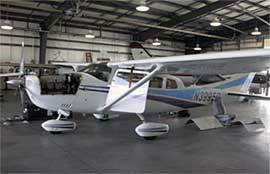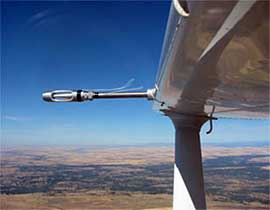Bigger, Better Cessna Ready to Record Aerosol and Carbon Cycle Data
Published: 30 September 2005

To meet new requirements in the airborne aerosol and carbon-cycle measurements taken over ARM’s Southern Great Plains (SGP) site, a new Cessna Turbo 206 is replacing the smaller Cessna 172XP. The new aircraft has been contracted by ARM to conduct combined in situ aerosol profiling and airborne carbon measurements for the next two years. Airborne measurements of carbon cycle trace gases at the SGP will provide data to quantify profiles of carbon dioxide (CO2) concentration from the surface to midtroposphere, carbon dioxide budgets in air-mass (in follow-on experiments), and contributions of fossil fuel combustion to atmospheric carbon dioxide. These data are considered essential for quantifying regional carbon exchange and tracing the balance between anthropogenic (human-produced) emissions and biogeochemical cycling, which are identified as priorities by the U.S. Climate Change Research Program and the North American Carbon Program.

Outfitted in collaboration with the National Oceanic and Atmospheric Association (NOAA), the Cessna Turbo 206 aircraft offers several improvements over the Cessna 172, which has been monitoring vertical profiles of aerosol properties over SGP since March 2000. One noteworthy advancement is its increased payload capability, in terms of weight, space, and electrical power. Another important improvement is the ability to provide measurements at an increased altitude of up to 18,000 feet.
While the Cessna 172 optics rack only had two nephelometers, the Cessna 206 will be equipped with four. These extra nephelometers will provide scattering data at two additional relative humidities, which give much better measurements of aerosol hygroscopic growth. The Cessna 206 system also provides data on the scattering of particles that are larger than 1 micrometer, which were not sampled by the Cessna 172.
The original carbon flask collection system from the Cessna 172 will be upgraded soon to provide samples at 12 heights or positions, rather than one. New instruments will be added to enable continuous carbon dioxide concentration profiles; CO and CH4 are also planned. In addition, event sampling for radiocarbon (14CO2) and radon will be used to quantify anthropogenic combustion emissions and vertical mixing, respectively. These data will facilitate calibration of the NASA Orbiting Carbon Observatory and, in combination with the tracers of fossil fuel and biomass combustion, will provide data for inverse methods that infer ecosystem exchange and anthropogenic emission of carbon dioxide on regional scales.
As its first assignment, the new turbo-charged Cessna 206 arrived at the SGP site in time to participate in the Aerosol Lidar Validation Experiment (ALIVE). (See below.)
The ARM Climate Research Facility is a DOE Office of Science user facility. The ARM Facility is operated by nine DOE national laboratories, including .
Keep up with the Atmospheric Observer
Updates on ARM news, events, and opportunities delivered to your inbox
ARM User Profile
ARM welcomes users from all institutions and nations. A free ARM user account is needed to access ARM data.


















